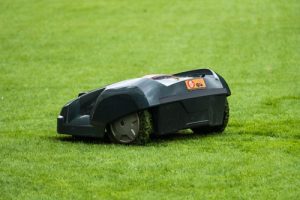For some, mowing the lawn is a meditative, almost spiritual experience. It’s a chance to tune out while getting a little exercise walking behind a lawnmower, while inhaling the scent of freshly cut grass. Some, on the other hand, absolutely hate the thought. It’s a numbingly repetitive, sweaty, noisy, waste-of-time job. Of course, we all want beautiful lawns. The question then is, how can you get a beautifully manicured lawn, when you absolutely hate it?
Enter Robotic Lawn Care. Robotic mowers resemble a Roomba, except they target grass instead of dust bunnies—traveling around your yard to keep your pasture in check with their spinning blades. Unlike their gas-guzzling, human-steered counterparts, these battery-powered bots are quiet enough to work at night (making about as much noise as a window-unit air conditioner). And because they run automatically on a schedule you set, you can deploy them with abandon. In fact, a robotic mower performs most effectively when used a few times a week, trimming a small amount each time. That way, the clippings are fine enough to sift back to the ground (instead of sitting on top of the grass to yellow in the sun.)
Two animal analogies are useful for understanding the operation of robotic lawn care. First, the machine works like a sheep, roaming about your lawn at random, nibbling away at the blades of grass in small increments. Second, they are prevented from leaving your lawn in much the same way that a dog can be contained within an electric fence.
Importantly, your Robotic lawn care machine needs to ‘see’ where it is going. As you begin to develop your own unique model, having UKA design and manufacture your precision lens will give your clients the confidence knowing that their new yard ‘friend’ will see everything it needs to.
Robotic mowers do require some labor-intensive set up. Before running one the first time, you must tack down the included low-voltage wire around the perimeter of your lawn, creating an invisible fence. After that, the machines pretty much run on autopilot. They’ll leave their charging base (which you’ve plugged into an outdoor outlet) and hit the field on a set schedule. If they bump into anything—a garden hose, your child’s trike—they’ll turn around and head a different direction. (A safety mechanism also stops the blade when the bot is lifted.) And when their batteries run low, they return to their base.
These robotic lawn mowers are still to gain popularity in the U.S., but are widely used in the European market, as lawn care is exceedingly expensive. To some, these may seem like a completely unrealistic invention, and to others who hate lawn care, but, want a perfect lawn, this is a dream come true.
With the coming in the Robotic age, and the development of the robotic mower, it’s easy to see that perhaps seeders and fertilizers could be next.
Universe Kogaku designs and manufactures optical lenses for robotics, security, high tech and electronic applications. We stock 1000’s of standard lens assemblies and can custom design a solution for scanners, CCTV, CCD/CMOS, medical imaging, surveillance systems, machine vision and night vision systems.